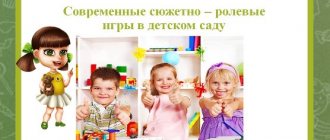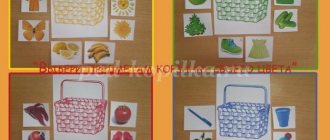Goals and objectives of board and printed games
A type of primary activity of preschool children, aimed at an analytical approach to solving a game situation, presented in the form of a visual aid, is called a printed board game.
Such games include:
- mosaics;
- didactic games in pictures (for example, a set of objects for the game “The Third Wheel”);
- folding cubes (in which the overall image is folded by turning over the faces of each cube);
- puzzles;
- lotto;
- domino;
- checkers, etc.
The goals of introducing board-printed games into the educational process are:
- consolidation or development of acquired knowledge;
- development of thinking processes, attention, memory, imagination and speech;
- training in perseverance, discipline and the ability to finish a job;
- fostering compliance, a tolerant attitude towards partners, and the ability to cooperate.
To achieve these goals, it is necessary to systematically solve the following tasks:
- consolidate knowledge about objects, their purpose, species differences;
- teach preschoolers to generalize objects according to essential features and identify relationships between them, as well as to compose parts into a whole;
- identify children’s interests (for example, compiling collective pictures from mosaic parts, putting together puzzles on a particular topic, etc.);
- develop the ability to play in small groups (children play in pairs, in threes, but if there are many participants in the group, it becomes difficult for them to decide on their role in the team - showdowns and quarrels begin);
- develop the skill of choosing play partners (by temperament, mood, etc., and not just by appearance);
- methodically competently build a system of interaction between children (the teacher plays the role of guiding the game process, but not the leader);
- encourage children's independence.
Visual material
Visualization is one of the main principles of gaming activities and the entire educational process in kindergarten. To carry out this work, certain visual aids are required. In other words, to create a picture from a mosaic, you need its diagram, and to create a picture from a puzzle, you need a solid image as a hint.
Games based on visual perception of information are associated with games such as:
- plot or symbolic pictures, images for the development of speech, mastering the basics of mathematics, familiarization with the world of things and nature, etc.;
- puzzles (including three-dimensional ones);
- lotto and domino sets;
- cubes;
- mosaics;
- “Adventure games” with chips and dice.
In order not to lead to hysterics, immediately stipulate that each child will have his own set of props, for example, a separate puzzle. If kids see such toys for the first time, then you need to give them time to get to know each other, and only then move on to playing. Please note that in younger groups, the folding process itself is important for children, so the picture should be the same - then there will be no tears. In older groups, you can give each student their own puzzle, and the pictures will be different. If time allows, then include in the game the stage of exchanging details: this way the kids will be able to put together different stories, and training motor skills and thinking will be more productive.
Another important point. For some games, for example, lotto, dominoes, it is assumed that there is one set for a certain number of players. But there may be more children in the group. In this case, you should take care of purchasing not one, but two sets. And divide the playing chips (or other game materials) equally.






